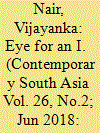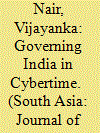|
|
|
Sort Order |
|
|
|
Items / Page
|
|
|
|
|
|
|
| Srl | Item |
| 1 |
ID:
159868


|
|
|
|
|
| Summary/Abstract |
In 2009, the Government of India embarked on a mission to issue each of India’s over one billion residents a unique biometric identification number, Aadhaar (literally, ‘foundation’). An Aadhaar database would link the demographic and biometric information (iris scans, fingerprints, facial photograph) of residents to a 12-digit number. India currently commands the world’s largest biometric database. While Aadhaar does not guarantee citizenship, benefits, or services, its architects submit that its reliable, real-time identity verification infrastructure potentially allows for the targeted delivery of any good to its intended recipient. Aadhaar is fashioned as an ID concerned with a pristine bodily uniqueness untarnished by the social, political, or economic. Aadhaar frequently provokes the questions: Who is the recipient of Aadhaar and to what community does Aadhaar afford membership? Based on ethnographic fieldwork in India’s capital, New Delhi, this article examines how Aadhaar comes to inform ideas of identity and belonging held by its implementers, as well as the population it targets.
|
|
|
|
|
|
|
|
|
|
|
|
|
|
|
|
| 2 |
ID:
167096


|
|
|
|
|
| Summary/Abstract |
Building on anthropological attention that has been devoted, appropriately, to the question of how states are spatialised, this article analyses how the swirl of discourse and everyday practice around India’s biometric identification programme serves to temporalise the state. The first half of the article examines how the Aadhaar initiative endeavours to assign the temporalising characteristics of innovativeness and expeditiousness to the contemporary Indian state. I show how mobility, change and speed are motivating factors for personnel at the Unique Identification Authority of India (UIDAI). In turn, I argue that Aadhaar is emblematic of the reimagination of the Indian state as a ‘start-up state’, or a lithe platform for innovation. I then explore the ways in which this start-up state is constructed in what one might call ‘cybertime’—a mode of imagining time that unsettles received understandings of historical time. In the second half of the article, I investigate how centralised efforts to temporalise the state are experienced by local implementers of Aadhaar as well as by its targets.
|
|
|
|
|
|
|
|
|
|
|
|
|
|
|
|
|
|
|
|
|